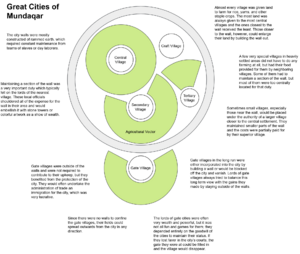Obodo nke Mba: Difference between revisions
No edit summary |
|||
| (3 intermediate revisions by the same user not shown) | |||
| Line 1: | Line 1: | ||
[[File:Obodo_nke_Mba.png | [[File:Obodo_nke_Mba.png|right|thumb|Diagram of a typical city]] | ||
'''Obodo nke Mba''' was a type of {{wp|Human_settlement|settlement}} and a {{wp|political system}} that prevailed in [[Mundaqar]] and later [[Tulura]] that was based on the concept of "Cities of the Country", or large walled settlements that enclosed several cooperative agricultural and industrial villages. Under this system, power was shared between the city's king and the leaders of villages who maintained specific sections of the wall called "nlegharị" translated alternately as patrols, watches, or vigils. These lords ("Nlegharimads" or "{{wp|Castellans}}") had to pay for the maintenance of their section of wall as well as organize soldiers to patrol it, but were provided with a "{{wp|Benefice|Nauzo}}" (translated as "vector") to help them pay for this project. Since the Castellans were allowed to expand their own lands by expanding their walls, they often did so, allowing the cities to became vast regions encompassing thousands of kilometers of land. The walls were generally {{wp|Earthworks_(engineering)|earthworks}} with a dry moat on the interior supplying the workers with material for the fortifications. Sometimes the walls were reinforced with wood or stone, or had a palisade at the top, or rarely were constructed entirely of stone. | '''Obodo nke Mba''' was a type of {{wp|Human_settlement|settlement}} and a {{wp|political system}} that prevailed in [[Mundaqar]] and later [[Tulura]] that was based on the concept of "Cities of the Country", or large walled settlements that enclosed several cooperative agricultural and industrial villages. Under this system, power was shared between the city's king and the leaders of villages who maintained specific sections of the wall called "nlegharị" translated alternately as patrols, watches, or vigils. These lords ("Nlegharimads" or "{{wp|Castellans}}") had to pay for the maintenance of their section of wall as well as organize soldiers to patrol it, but were provided with a "{{wp|Benefice|Nauzo}}" (translated as "vector") to help them pay for this project. Since the Castellans were allowed to expand their own lands by expanding their walls, they often did so, allowing the cities to became vast regions encompassing thousands of kilometers of land. The walls were generally {{wp|Earthworks_(engineering)|earthworks}} with a dry moat on the interior supplying the workers with material for the fortifications. Sometimes the walls were reinforced with wood or stone, or had a palisade at the top, or rarely were constructed entirely of stone. | ||
| Line 23: | Line 23: | ||
==See Also== | ==See Also== | ||
*[[Tvrdjava]] | *[[Tvrdjava]] | ||
*[[Benteng]] | |||
*{{wp|Bastide}} | |||
[[Category:Mundaqar]] | [[Category:Mundaqar]] | ||
Latest revision as of 19:48, 18 February 2020
Obodo nke Mba was a type of settlement and a political system that prevailed in Mundaqar and later Tulura that was based on the concept of "Cities of the Country", or large walled settlements that enclosed several cooperative agricultural and industrial villages. Under this system, power was shared between the city's king and the leaders of villages who maintained specific sections of the wall called "nlegharị" translated alternately as patrols, watches, or vigils. These lords ("Nlegharimads" or "Castellans") had to pay for the maintenance of their section of wall as well as organize soldiers to patrol it, but were provided with a "Nauzo" (translated as "vector") to help them pay for this project. Since the Castellans were allowed to expand their own lands by expanding their walls, they often did so, allowing the cities to became vast regions encompassing thousands of kilometers of land. The walls were generally earthworks with a dry moat on the interior supplying the workers with material for the fortifications. Sometimes the walls were reinforced with wood or stone, or had a palisade at the top, or rarely were constructed entirely of stone.
Political relationships within the cities were determined by proximity to the wall, which carried a high degree of cost and responsibility, and to the Etitibe, the capital settlement where the sovereign's palace was located. Settlements closer to the Etitibe had fewer obligations to the maintenance of the walls and therefore tended to be wealthier, but they also had less influence in the administration of the city as a whole. These interior villages without a direct association with the wall were called Nsoje and unlike the wall-villages, they were free to have non-monarchical forms of government. Occasionally Nsoje were ruled by councils of elders or by several aristocrats called Mkpimads or Atomads.
The lord of the Etitibe, which typically controlled a hill fort or some other small fortification in addition to a town, was called the Mgbasamad. The Mgbasamad's duty was to oversee the whole wall and to lead the army in wartime. During peacetime, however, he was primarily responsible for the distribution of skilled workers throughout the city. Every village was supplied with some specialist such as a priestess, a blacksmith, or a mason. As a result, the Mgbasamad was seen as the honorary head of most professions. When an apprentice completed his training, he would journey to the capital where the Mgbasamad's court would give him an assignment to a village along with a small gift of money or material. In turn, the individual villages paid a special tax to the Mgbasamad based on the number of skilled workers present. Occasionally, the Mgbasamads would establish craft villages, which did not have an associated plot of land for subsistence. These typically formed around specialized plantations for cotton or palm oil and did not pay a craftsman tax; those villages were a way for the monarch to keep a reserve of highly trained professionals for his own use, to train others, or to wait for reassignment.



